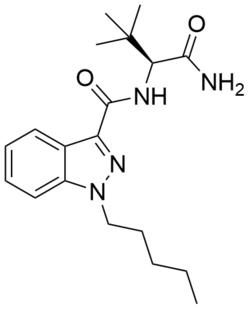Chemistry:ADB-PINACA
 | |
| Legal status | |
|---|---|
| Legal status |
|
| Identifiers | |
| |
| CAS Number | |
| PubChem CID | |
| ChemSpider | |
| UNII | |
| Chemical and physical data | |
| Formula | C19H28N4O2 |
| Molar mass | 344.459 g·mol−1 |
| 3D model (JSmol) | |
| |
| |
ADB-PINACA is a cannabinoid designer drug that is an ingredient in some synthetic cannabis products. It is a potent agonist of the CB1 receptor and CB2 receptor with EC50 values of 0.52 nM and 0.88 nM respectively.[1][2] Like MDMB-FUBINACA, this compound contains an amino acid residue of tert-leucine.
Side effects
ADB-PINACA has been linked to multiple hospitalizations and deaths due to its use.[3][4][5]
Metabolism
Nineteen ADB-PINACA major metabolites were identified in several incubations with cryopreserved human hepatocytes. Major metabolic reactions included pentyl hydroxylation, hydroxylation followed by oxidation (ketone formation), and glucuronidation.[6]
Legality
ADB-PINACA is listed in the Fifth Schedule of the Misuse of Drugs Act (MDA) and therefore illegal in Singapore as of May 2015.[7]
In the United States, it is a Schedule I controlled substance.[8] but its 5'-bromo analog ADB-5'Br-PINACA is not as of October 20th, 2023.
As of October 2015 ADB-PINACA is a controlled substance in China.[9]
See also
References
- ↑ "Pharmacology of Indole and Indazole Synthetic Cannabinoid Designer Drugs AB-FUBINACA, ADB-FUBINACA, AB-PINACA, ADB-PINACA, 5F-AB-PINACA, 5F-ADB-PINACA, ADBICA, and 5F-ADBICA". ACS Chemical Neuroscience 6 (9): 1546–59. September 2015. doi:10.1021/acschemneuro.5b00112. PMID 26134475.
- ↑ "ADB-PINACA". Forendex. http://forendex.southernforensic.org/index.php/detail/index/1257.
- ↑ "CDC: 221 sickened by synthetic pot in Colorado". USA Today. December 12, 2013. https://www.usatoday.com/story/news/nation/2013/12/12/synthetic-pot-colorado/4005257/.
- ↑ "A Common Source Outbreak of Severe Delirium Associated with Exposure to the Novel Synthetic Cannabinoid ADB-PINACA". The Journal of Emergency Medicine 48 (5): 573–80. May 2015. doi:10.1016/j.jemermed.2014.12.038. PMID 25726258. PMC 9049074. http://www.jem-journal.com/article/S0736-4679%2814%2901425-5/abstract.
- ↑ "Synthetic Cannabinoid-Related Illnesses and Deaths". The New England Journal of Medicine 373 (2): 103–7. July 2015. doi:10.1056/NEJMp1505328. PMID 26154784.
- ↑ "Distinguishing Intake of New Synthetic Cannabinoids ADB-PINACA and 5F-ADB-PINACA with Human Hepatocyte Metabolites and High-Resolution Mass Spectrometry". Clinical Chemistry 63 (5): 1008–1021. May 2017. doi:10.1373/clinchem.2016.267575. PMID 28302730. http://clinchem.aaccjnls.org/content/63/5/1008.long.
- ↑ "CNB NEWS RELEASE". Central Narcotics Bureau (CNB). 30 April 2015. http://www.cnb.gov.sg/Libraries/CNB_Newsroom_Files/CNB_NR_-_30_Apr_2015.sflb.ashx.
- ↑ Drug Enforcement Administration, Department of Justice (February 2014). "Schedules of controlled substances: temporary placement of four synthetic cannabinoids into Schedule I. Final order". Federal Register 79 (27): 7577–82. PMID 24605391.
- ↑ "关于印发《非药用类麻醉药品和精神药品列管办法》的通知" (in Chinese). China Food and Drug Administration. 27 September 2015. http://www.sfda.gov.cn/WS01/CL0056/130753.html.
 |
